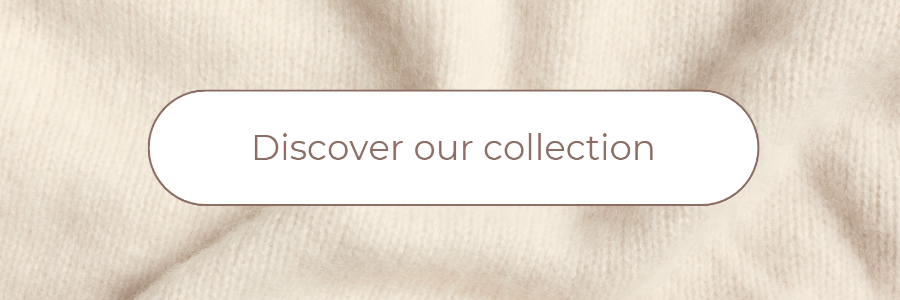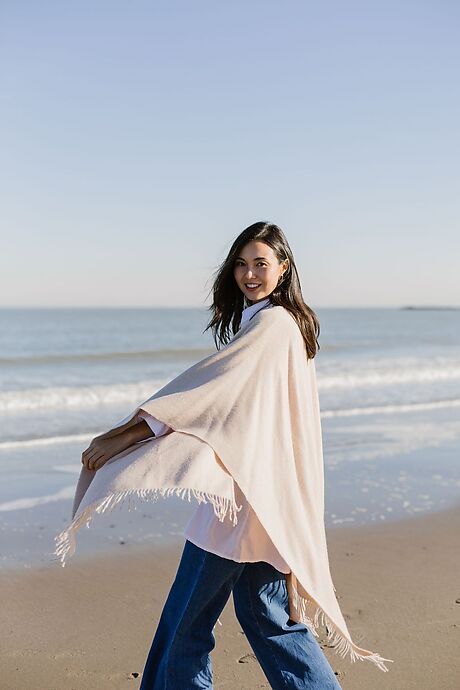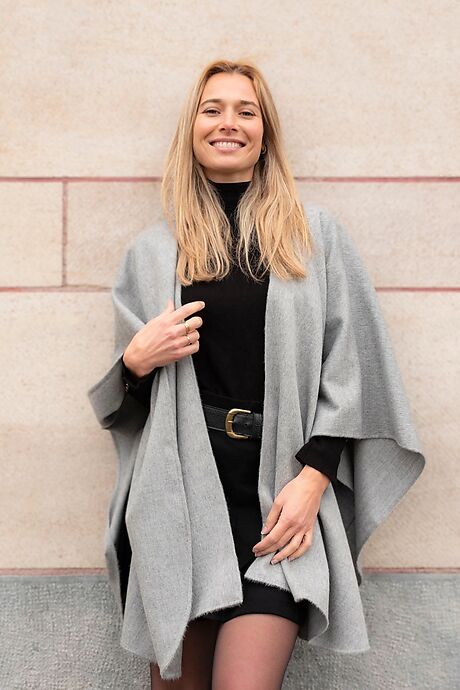Cashmere poncho

Cashmere poncho
What is cashmere?
Cashmere originally comes from the goat. For this rare and expensive wool to be called cashmere, the diameter of the goat's hair must be less than 19.5 microns. The hair must also contain at least 30% more down than a traditional hair. Cashmere is therefore an animal fibre that comes from the long, soft and silky undercoat of goats. This is where the secret of the cashmere name lies. This fabric is produced and manufactured in a very limited geographical area. This area extends from the north of Indo-Pakistani Kashmir to the north of Mongolia.
In winter, the goats protect themselves from the cold and icy wind, between -30 and -40°C, thanks to their very condensed down made up of fine and supple hair which forms a second layer of hair which doubles their summer coat. This down is recovered at moulting time. The down is dark grey in colour and is sheared or brushed off the goats' chest in the spring.
There are different types of cashmere fibre:
- Raw fibre: this is the fibre that has not yet been processed, by which we mean the fibre that comes directly from the goat.
- The treated fibre: this is when the least fine hairs have been removed from the fibre. This is when it is washed and ready to be transformed into yarn for sewing or knitting.
- Virgin fibre: this is when the fibre has been processed into yarn, clothing or fabric for the very first time.
- Recycled fibre: this is when fabric scraps that have already been woven or felted are recovered. It is often a question of fibres that have already been used.

The history of cashmere
Cashmere hair is a very fine fibre of between 19 and less than 12 microns harvested at the end of winter from goats. Cashmere takes its name from the region of Kashmir. The first cashmere industry in this region was established around the 15th century. Europe discovered this new material towards the end of the 18th century in the wake of the Egyptian campaign. At that time, the French empress Josephine recommended the cashmere shawls that her husband Napoleon gave her. It was then that European entrepreneurs set off on an expedition to discover Asia with the aim of introducing this fibre to the European continent. These entrepreneurs brought goats back to Europe, but unfortunately they did not survive our climate. However, this did not prevent them from mastering the know-how.
European production began in the early 19th century. It was not until 1830 that the cashmere industry developed in Scotland, inspired by French crafts. The cradle of the cashmere hair industry began in Massachusetts, USA. At the same time, Italy and China developed their cashmere industries. In France, it is Eric Bompard who is partnering with the world's leading cashmere producer, Erdos, in 2020.
Cashmere poncho
The cashmere poncho is a must-have for any woman's wardrobe! It is a fashionable and above all, timeless accessory that will keep you warm from autumn to spring while highlighting your elegance and class. The cashmere poncho is both light and refined, it can be adapted to all your outfits and will undoubtedly remain a must-have accessory because it stands out for its finesse and distinction unlike the more traditional large ponchos. It is the ultimate chic piece to have in your wardrobe! The cashmere poncho for women has an impeccable fall that brings refinement and comfort to your outfits. It is the little touch of sophistication that will finalize your look. Indeed, the cashmere poncho is less classic than a jumper, but more original than a simple jacket. It is an emblematic accessory for women that will accompany you perfectly during the mid-seasons. The cashmere poncho is worn over your daytime clothes. It will warm you up and emphasize your silhouette while highlighting your femininity.
Poncho vs cape
The most striking difference between a poncho and a cape is that a poncho has an opening to let your head through, whereas a cape simply sits on your shoulders. For example, the poncho is put on like a jumper without sleeves, much like a cape. The poncho is similar to a large square of fabric with a hole in the middle to let the head through. It also exists in several materials such as: cashmere poncho, alpaca wool poncho, wool poncho, ...The cape is rather similar to a large scarf or a cape. It has a wider cut and is simply placed on the shoulders. It can be put on like a waistcoat and let hang down the body.

The origin of the poncho
The poncho originated in South America. Many years ago, the Indians dressed themselves by cutting a large square out of rolls of cloth and making a hole in the middle to let their heads through. This helped them to keep out the cold and damp while still allowing them to move freely. Ponchos from South America are known for their more than folkloric designs and, above all, their bright, vibrant colours. They are then declined in several materials like the wool poncho, the cashmere poncho, the alpaca wool poncho, ...
And why not opt for an alpaca wool poncho?
On long winter evenings, the alpaca wool poncho from South America is ideal for covering up. It can be combined with any look, with trainers or heels, always keeping the chic and elegant look. Our ponchos are made of 100% baby alpaca wool. They are available online and in shops in a variety of colours to match your current look. Our baby alpaca wool ponchos are a perfect combination of elegance, well-being, warmth and comfort. Our ponchos are warmer than a cashmere poncho.


Our handmade ponchos for women
BellePaga ponchos are full of qualities, they are warm, soft, light and offer an optimal comfort to anyone who wears them. They are perfect for cooler evenings and mid-seasons. They will keep you warm thanks to their thermoregulatory properties that will maintain your natural body heat. Depending on the occasion, you can wear it with a pretty little dress or trousers for a sophisticated or more casual style. You'll see that you won't be able to do without it and that it will quickly become a wardrobe staple!
Our ponchos are made from real baby alpaca wool which makes them one of the softest and warmest ponchos compared to a cashmere poncho. They have a clean design that can be worn in all circumstances thanks to the fact that our ponchos have very simple borders and a wide range of colours. Our ponchos have the particularity to keep you warm without making you sweat. So the cold of winter will no longer be a problem for you! Our secret is that each baby alpaca wool poncho is hand-finished by Peruvian craftsmen renowned for their talent. These ponchos will suit all women who want to combine elegance and finesse without sacrificing warmth and comfort. Thanks to this, you will no longer have to choose between elegance and warmth!
Poncho in Alpaca wool
Alpaca fibre can be divided into two main categories: Alpaca fibre and Baby Alpaca fibre. Baby Alpaca fibre is fine, i.e. it measures between 14 and 23 microns and does not necessarily come from young Alpacas. This wool comes from the first shearing of the animal that still has its fine coat of fur. Alpaca fibre, on the other hand, is a little thicker and measures between 23 and 26 microns. The softness of Baby Alpaca wool can easily be compared to the softness of silk, as they are both very soft, silky and shiny. This soft wool can be worn next to the skin as Baby Alpaca wool is considered to be one of the softest and most prestigious natural fibres in the world. It is both rare and prestigious because it represents less than 10% of the total world production of Alpaca fibre. This is why Baby Alpaca fibre is classified as a premium fibre and why we have selected it in most of our articles so that you can make the most of it. Alpaca wool is different from other wools because it is 7 times more elastic than sheep's wool, and its insulating thermal properties allow you to wear light and comfortable clothes while keeping you protected from the cold. The last little plus is that Alpaca wool has a high level of resistance and does not pilling so you can keep it longer!
Come and discover or rediscover our Baby Alpaca wool ponchos and the rest of our collection for women!
-
Warmi Poncho
289,00 €
-
Ruana Rumi
295,00 €




